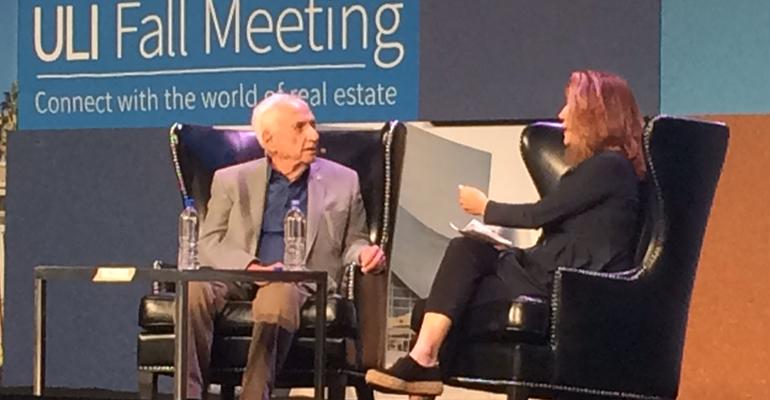- Large infusions of Asian and Canadian capital are creating an oversupply of upscale condominium units in Los Angeles, according to panelists at the opening general session “Los Angeles: Much More Than La La Land.” “On the positive side, the Asian/Canadian capital is helping the city revitalize,” said Robert J. Lowe, Sr., chairman of the board and CEO of Lowe Enterprises, a Los Angeles-based real estate investment firm. “But they are either overly optimistic about absorption or they are calculating differently than we are. I think there will be oversupply, and it will take a few years to absorb.” According to another panelist, Wayne Ratkovich, president and CEO of the development firm The Ratkovich Company, foreign investors may be putting their money into the condo units because they view the Los Angeles market as a safe haven and because some of them may be looking to take advantage of the EB-5 residency provisions. As a result, “they are not looking for a rate of return that [we] are.”
- Meanwhile, architect Frank Gehry, who delivered the keynote address on Tuesday, noted that as a result of the new projects “I look at what’s going on downtown and it looks like every other city in the world.”
- As California gets ready for a boom in driverless vehicles in the near-term future, the panelists also advised developers to build parking garages that can be easily converted to another use if necessary, “maybe future living or office arrangements,” according to Ted Tanner, executive vice president of real estate with sports and entertainment presenter AEG. The flexible parking structures should feature flat floors and higher ceiling heights.
- As the opening session panel discussed the need to incorporate seniors housing into new mixed-use projects, Robert J. Lowe, Sr. noted that there may be an opportunity for some struggling class-B malls to be converted into mixed-use properties with seniors housing components.
- As the Federal Reserve begins its “great unwinding,” “liquidity is going to change in this country big time in the next few years,” as roughly $4 trillion in capital will be taken out of the market, cautioned Charles A. Long, president of Oakland, Calif.-based real estate development firm Junction Properties LLC and author of the book “Finance for Real Estate Development.” He noted that cap rates are currently at “unprecedented highs compared to the 10-year Treasury.” “That high is the result of the perception that the good times are not going to last and people want to hedge their bets. That skepticism is fairly accurate,” Long said.
- A dire lack of both affordable and workforce housing is contributing to the growing homelessness problems in cities around the country, according to the participants in “A Serious Conversation about Homelessness” panel. In Los Angeles, there is a gap of 550,000 affordable rental units compared to the amount of demand, according to Dhakshike Wickrema, assistant senior deputy for homelessness and mental health with Los Angeles County. The shortage is similarly dire in Seattle, noted George Scarola, director of homelessness with the Seattle Mayor’s office. “The affordable housing crisis is feeding homelessness in a way that we can’t keep up with,” he said.
- One temporary solution to the homelessness problem that Seattle is experimenting with involves tiny home villages that use very basic wood construction. “They work because the [formerly homeless] people in them have a stake in protecting the community,” said Scarola. But while the homes are more aesthetically pleasing than having encampments of homeless people on the street, Scarola conceded they have been a tough sell to property owners and tend to be placed in the less expensive parts of the city due to land availability.
- Touching on the recent boom in real estate crowdfunding firms, John McNellis, co-founder of Palo Alto, Calif.-based development firm McNellis Partners, divided the crowdfunding sector into two groups: firms that simply connect investors with developers and firms that invest in projects themselves. The first concept should work in the long term, he noted. But when it comes to crowdfunding firms underwriting real estate deals, McNellis pointed out that it takes at least a decade in the business to become a reliable underwriter. “To expect these 20-year-olds who are good at tech to be good at underwriting” is unrealistic, he said. McNellis added that established developers normally already have financial partners that they prefer to work with. The developers most in need of crowdfunding dollars would be either those just starting out in the business or developers with a spotty track record.
- McNellis, whose firm invests in shopping centers in addition to office buildings, also noted that the S. retail sector would be experiencing its current challenges whether it was facing the threat from Amazon and other e-commerce sites or not because of the oversupply of retail space in the United States. “Even the best retailers are shrinking,” he noted. McNellis predicted that as chains including Sears, Kmart and J.C. Penny continue on their inevitable decline, Amazon may invest in one of them as a distribution channel, similar to the deal it made with Whole Foods.
- He also noted that the high-stakes competition by hundreds of U.S. cities to become the home of the second Amazon headquarters doesn’t make sense in either financial or ideological terms. Amazon needs to go to whichever market can offer it young tech talent, so “the city that gets Amazon doesn’t need to give them anything,” McNellis pointed out. In addition, “I don’t think we should be giving money to tech companies who are putting mom-and-pops out of business,” he said.
1 comment
Hide comments

